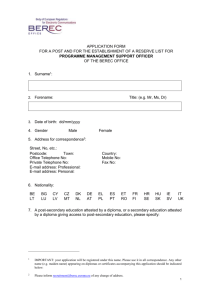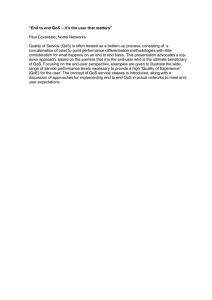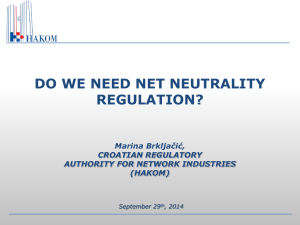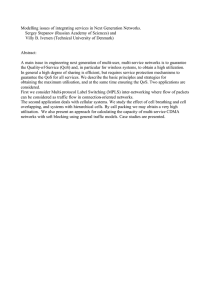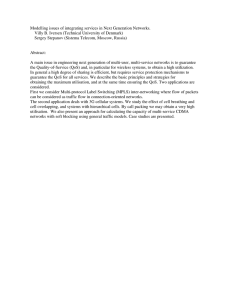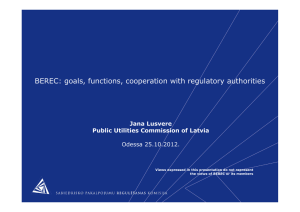Briefing on BEREC’s NN QoS Work
advertisement
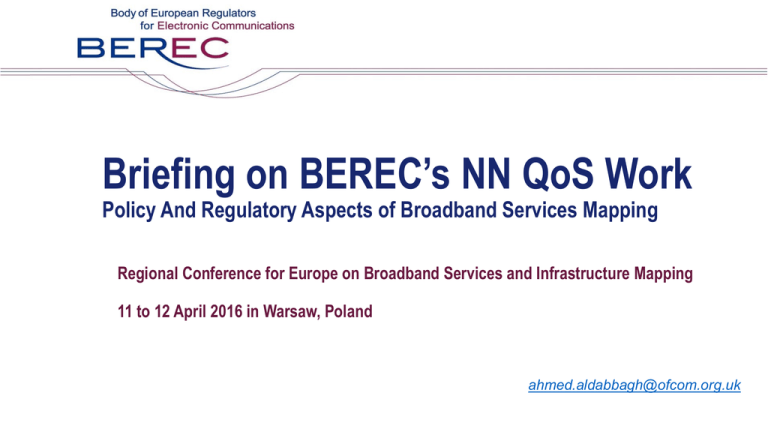
Briefing on BEREC’s NN QoS Work Policy And Regulatory Aspects of Broadband Services Mapping Regional Conference for Europe on Broadband Services and Infrastructure Mapping 11 to 12 April 2016 in Warsaw, Poland ahmed.aldabbagh@ofcom.org.uk What is BEREC? • • • Body of European Regulators for Electronic Communications Established by Regulation (EC) No 1211/2009 of the European Parliament and of the Council of 25 November 2009, as part of the Telecom Reform package Successor to European Regulators Group (ERG), established in 2002 as advisory group to the EC Main role • Assists the EC and the national regulatory authorities (NRAs) in implementing the EU regulatory framework for electronic communications • Provides advice on request and on its own initiative to European institutions 1 How does BEREC work? The Board of Regulators (BoR) (a regulatory network) • Make the decisions • One member per EU Member State • Meets 4 times a year (Plenary Meetings) • Includes observers: EFTA, EEA, accession states, and Commission The Expert Working Groups • Deliver BEREC’s Work Programme • Created by BoR and set up by BEREC Office Benchmarking End User Regulatory Accounting Regulatory Framework BoR MC The Management Committee (MC) • Oversees the Office and the BEREC budget, and appoints the Administrative Manager • One member per EU MS + Commission • Includes observers: EFTA, EEA, accession states Contact Network The Contact Network (CN) • Prepares decisions to be taken by BoR and MC • Meets 3 weeks before relevant Plenary Meetings • Includes observers Expert Working Groups Market & Economic Analysis Net Neutrality Next Generation Networks Remedies Roaming 2 NN QoS activities – past and present 2011 2012 NN QoS Framework •QoS concepts and evaluation • Types of congestion • Specialized services • Most relevant QoS Indicators: throughput, latency, jitter, packet loss • Generic and application-specific degradation 2013 NN QoS Guidelines (Public Consultation) • Guidance on when and how to exercise powers to impose minimum QoS requirements • 3 pilars: - Ensuring that market forces work -Monitoring QoS over time - Case-by-case investigations of NN incidents 2014 NN QoS Monitoring (Public Consultation) • More detailed study of QoS metrics • Promotion of crowdsourcing platforms • Mainly active measurements based on injected traffic • Proposes further study of a common measurement platform 2016 2015 NN QoS Feasibility Feasibility of a common measurement platform: technical, legal and economic issues 2018 NN Guidelines and Toolkit Current effort New European single telecom market regulation 3 Legal Basis USD art. 21(3c) NRAs are able to oblige undertakings to “inform subscribers of any change to conditions limiting access to and/or use of services and applications” USD art. 21(3d) NRAs are able to oblige undertakings to “provide information on any procedures put in place by the provider to measure and shape traffic so as to avoid filling or overfilling a network link, and on how those procedures could impact on service quality” USD art. 22(3) NRAs “are able to set minimum quality of service requirements on an undertaking or undertakings providing public communications networks.” USD art. 22(1) NRAs are able to “require undertakings that provide publicly available electronic communications networks and/or services to publish comparable, adequate and upto-date information for endusers on the quality of their services” USD art. 22(2) NRAs may “specify, inter alia, the quality of service parameters to be measured and the content, form and manner of the information to be published, including possible quality certification mechanisms” New European single telecom market regulation Regulation (EU) 2015/2120 of the European Parliament and of the Council of 25 November 2015 laying down measures concerning open internet access and amending Directive 2002/22/EC on universal service and users’ rights relating to electronic communications networks and services 4 New Legislation: Open Internet Access • • • • • • • Article 1 Subject matter and scope Article 2 Definitions Article 3 Safeguarding of open internet access Article 4 Transparency measures for ensuring open internet access Article 5 Supervision and enforcement Article 6 Penalties Article 10 Entry into force and transitional provisions 5 2014-16 BEREC Programme Previous work • 2014 BEREC NN QoS Monitoring Report: - What to measure - How to measure • 2015 BEREC NN QoS Feasibility Study: - Collaborative monitoring 2015-16 Guidelines for the implementation of Net Neutrality provisions of the TSM regulation • Work-in-Progress until 30. Aug 2016 2016-17 Regulatory assessment of QoS in the context of Net Neutrality Kick-off September 2016 6 Feasibility study of a common measurement platform • Recommendations on feasible quality monitoring metrics & methods • Architectural options of a common measurement system (centralized, different degrees of decentralization) • Legal and economic assessment 7 2016 Regulatory assessment of QoS Aim: develop methods and tools for NN QoS regulatory assessment • Specifying the opt-in QoS monitoring software functionality. • Development of regulatory assessment toolkit. • Monitoring will encompass both IAS as a whole and individual apps: Measure IAS performance: up/download speed, latency etc. Scrutinize ISPs’ traffic management practices • Developing a collaborative framework for multi-NRA monitoring, specifying methodology for overall system governance • BEREC advocates adoption of existing standards and architectures. 8 Timescale BERECs NN QoS regulatory assessment activity is due to start in September 2016. • First year – to specify opt-in monitoring software and initiate development of regulatory assessment toolkit. • Second year – to develop monitoring opt-in software. This is subject to BEREC BoR approval. • Status of BEREC guidance work on QoS/NN measurement: Future toolkit and existing body of work all represent guidance to NRAs and hence fall under the banner of Best Practice. 9 Challenges for monitoring Internet service quality 1. Harmonization of measurement methodologies of basic performance parameters (throughput, delay, jitter, packet loss) Significant variations in current measurement tools used by NRAs (NDT, Ookla, Samknows, NRA tools) There is no single best tool for doing the measurements; nevertheless, measurements with the same tool are required for comparability What is best practices ? 10 Challenges for monitoring Internet service quality 2. A toolbox for monitoring NN violations Different traffic management practices may be used, and each practice requires a different detection method: blocking/throttling based on port numbers (TCP/UDP ports) blocking/throttling using DPI (Deep Packet Inspection) or DCI (Deep Content Inspection) traffic shaping Current public tools (Glasnost, Shaperprobe, NANO, Neubot, Netalyzr) are not so useful to regulators some tools have not been sufficiently tested in real networks (e.g. Shaperprobe, NANO) most tools (except Shaperprobe, Netalyzr) do not pinpoint the cause of differentiation may produce inconclusive results (due e.g. to cross-traffic) have much smaller number of users, compared to speed measurement tools may not be actively supported by the development community Monitoring over time on different time scales (hours to weeks or months) is necessary 11 Challenges for monitoring Internet service quality 3. A proper sampling plan Aggregate statistics over population groups (e.g. mean performance result of an ISP, for a specific access technology, over a specific area, etc.) must be derived from a proper sampling plan Even a good tool can produce totally far-off results, if sampling is wrong Good sampling practices: determine the required estimates and population groups study population sizes from market data (estimate size and variance) to provide input for selecting sample sizes stratify the population if highly variable check variations of single user measurements to determine a minimum required number of single user measurements for inclusion in the sample 12 BEREC and NN Expert Working Group Current BEREC list of publications on net neutrality as of January 2016, encompassing economics, technical and legal aspects: • Guidelines on Transparency in the scope of Net Neutrality, 2011 • A framework for Quality of Service in the scope of Net Neutrality, 2011 • Traffic Management Investigation, 2012 • Guidelines for quality of service in the scope of net neutrality, 2012 • Differentiation practices and related competition issues in the scope of NN, 2012 • An assessment of IP interconnection in the context of Net Neutrality, 2012 • Overview of BEREC’s approach to net neutrality (4 pages), 2012 • Summary of BEREC positions on net neutrality (12 pages), 2012 • Monitoring quality of Internet access services in the context of net neutrality, 2014 and Annex • How consumers value net neutrality (Ecodem), 2015 • Feasibility study of quality monitoring in the context of net neutrality (London Plenary 2015) Please, click on link to load the publication when available. 13 http://berec.europa.eu Thank you Ahmed Aldabbagh, BEREC ahmed.aldabbagh@ofcom.org.uk 14
